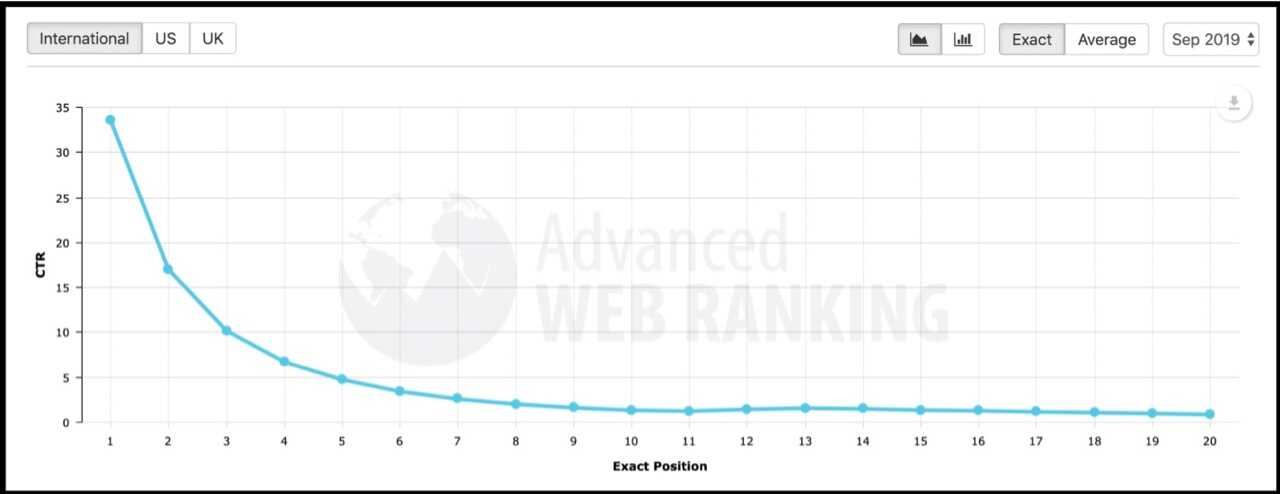BERT, Google’s most recent algorithm update affects 10% of all searches. But how can you benefit from the BERT update, and how can you help Google send more potential customers to your website? It’s all about mastering SEO and digital marketing.
Google and other search engines have long replaced the yellow pages. As competition for top online searches increases, we need to find new ways to get our name ahead of our competitors.
More than ever, businesses rely on the internet to gain more customers, and this trend will only increase with traditional media seeing significant decreases all across the board. According to Internet Live Stats, Google now processes over 40,000 search queries every second on average, which translates to over 3.5 billion searches per day and 1.2 trillion searches per year worldwide.
As you can see from the below screenshot of an Advanced Web Ranking case study, nearly 60% of all clicks in the Google SERPS will go to the first three organic (aka natural) search results:

This means that if your website doesn’t rank in the top three search results for your target SEO keywords, there’s a slim chance that someone will click through to your site.
Google’s Algorithm: A Moving Target
As you can see from the graphic below, the search giant’s global market share now exceeds 93%:
Source: StatCounter Global Stats – Search Engine Market Share
Most of us trust that Google’s algorithm presents us with the most relevant information. Their algorithm is probably the best-kept secret in the world, and it’s no surprise that Google does everything possible to stay ahead of their competition.
While Google makes three to five minor changes to its algorithm every day, the significant updates get a lot of attention since they can affect businesses around the world in dramatic ways. The latest algorithm update has been named BERT, which stands for Bidirectional Encoder Representations from Transformers. According to Google, BERT is an open-source neural network-based technique for natural language processing (NLP). Google also states that this technology enables anyone to train their own state-of-the-art question answering system.
I’m not going into too much detail about BERT. However, this algorithm update is massive since the search giant has gained yet another huge advantage and technological advancement over its competition. This update means that Google users will find the right information in less time. Moving forward, BERT makes the search engine smarter and smarter, and I’m excited (and also a bit scared) how this effort develops.
BERT: How Can You Benefit from Google’s Latest Algorithm Update
The best way to benefit from BERT and future algorithm updates is to implement a high-quality digital marketing and SEO strategy. As mentioned above, if your site is not showing up in the top organic search results, you are missing out on getting potential customers to your website. SEO is not rocket science, but if done right, it can yield amazing results. After attending one of our SEO training courses, we teamed up with one of the class attendees to help them implement a powerful search engine optimization strategy.
As you can see from the Google Analytics screenshot below, applying and executing a winning strategy can have tremendous results. This increase in Google organic search traffic also resulted in an 800% increase in revenue:

What Components Need to Be Part of a Powerful Digital Marketing Strategy?
To please the search engines, you need to implement something that I call the “5 Pillars of SEO and Digital Marketing” Methodology. Google’s algorithm now consists of roughly 250 main ranking signals (and potentially thousands of sub ranking signals), and the better you address all of these ranking signals, the better your website will rank in the search engine results pages (SERPs). You can place each of these main ranking signals onto one of the following five pillars:
1. The Technical Health of a Website
2. The Functionality and User Experience of a Website
3. On-Page Search Engine Optimization
4. Off-Page Search Engine Optimization
4. Social Media Marketing
The foundation of these five pillars is a content marketing strategy.
In this article, I’ll discuss on-page SEO and content marketing, two of the components that are most important to address the BERT algorithm update. I’ll also briefly explain why social media marketing needs to be part of your digital marketing game plan.
If you’re not sure about the technical health, the functionality and user experience of your website, make sure to use our free site audit tool. In less than a minute, our website audit tool creates a 10-page report and delivers it as a PDF straight to your inbox. My team and I will be happy to discuss the findings of the audit in a complimentary in-person or screen share meeting with you if you’d like:
What’s Your SEO Score?
Enter the URL of any landing page or blog article and see how optimized it is for one keyword or phrase.
On-page SEO and Content Marketing Best Practices: Start With Keyword Research for SEO
If you want to rank high in online searches, you first need to research and determine the keywords and phrases that are most important for your business.
Keywords and search phrases, which are what people enter into a search engine, are the foundation of your SEO strategy. To determine what keywords to use in your strategy, you must do keyword research to get real data – you can’t just guess. Fortunately, you can use all kinds of tools, both free and paid, to help you get started.
I usually recommend using the Google Keyword Planner tool. However, this tool is part of Google Ads and requires you to set up an active Ads campaign for you to get full functionality. Another great tool you may want to check out is SerpStat. Tools are an essential part of the keyword research process, and it’s something we address in great detail in our workshops. I recently recorded the below 12-minute tutorial on how to get started with keyword research for SEO and hope that you’ll find time to view it:
Make sure to read our step-to-step SEO keyword research guide for additional tips and best practices.
Once you’ve researched and identified your target SEO keywords, you’ll want to put those keywords to work by implementing a content marketing strategy. I’m sure you’ve heard the phrase “content is king.” Well, the saying should be “high-quality, search engine optimized, content is king. Simply creating content for the sake of creating content doesn’t work anymore if you’d like to succeed with SEO. Creating high-quality content takes time, resources, and expertise, but you have to do it if you’d like to see results. After all, the BERT algorithm update will reward you for creating the best possible content that is useful to your target audience. Content marketing may seem like a daunting task, but it doesn’t have to be. If you don’t have the resources internally, time, or know-how, you can hire contract writers.
If you’re able to implement a robust content marketing strategy, Google will eventually reward you, and you’ll see a boost in organic traffic to your website. On the flip side, websites with lower-quality content will lose search rankings and traffic to those websites that provide more useful content. It’s as simple as that and fantastic news for businesses that are willing to put in the effort.
As a small business owner myself, I’ve personally seen the results of producing high-quality content for our customers and my businesses. Combining the craft of writing high-quality content and the art of search engine optimization will result in driving more qualified traffic to your website, and ultimately, you’ll see more leads and sales from your site.
As mentioned earlier, there are currently approximately 250 rankings signals in Google algorithm, so try to address and optimize for as many of those ranking signals that you can. It can be a bit overwhelming, but it’s doable. At the very least, make sure that all web pages of your website are correctly indexed in Google (you can use Google Search Console to see if they are), all meta tags are properly optimized, and that your website is mobile-friendly. There’s so much more to SEO, and I invite you to check out our self-paced, non-technical, online SEO training course for additional tips and best practices.
Love It Or Hate It, Social Media Marketing Needs to Be Part of Your SEO and Digital Marketing Strategy
Like it or not, marketing through social media is here to stay, and you need to take advantage of these platforms to build your brand equity. Google has teamed up with several social media platforms and frequently includes social media pages in its search engine results pages. If you don’t have a social media marketing strategy yet, here are a few tips to get you started:
1. It’s imperative to understand your customers and do your research to determine what social media sites your customers visit and when. You don’t want to use every social media platform because it won’t be effective, and you’ll have difficulty keeping up with it. So do your research and start with the 2-3 main sites that your customers use.
2. Plan the content you want to develop and use a calendar to track the process.
3. Select a social media tool that you can use to track your postings, responses, and overall data. Make sure to monitor who and how many people are talking about your products, services, and brand. You should also monitor the growth in social media followers and the content that they engage with the most.
Beyond just being on these social channels, people must share your content. The more they do this, the higher the ranking you should see. It’s no coincidence that the top search results are often the ones that have the most shares. The more hits a business website receives, the more valuable the site becomes in the eyes of search engines.
Ginny Hampton, Social Media Specialist at SocialSEO, joined me in presenting an hour-long webinar entitled “Top Ways to Boost Your Social Media Strategy” and I hope you find some time to view the recording of this webinar:
Conclusion
Businesses need to understand that intimately knowing who their ideal customers are and what information they need is critical to succeeding with digital marketing. We all turn to the search engines and social media marketing platforms to look for particular information. So don’t try to be everything to everyone! Be the expert that you are and customize and personalize your content so that you can cut through the clutter and adds value to your target audience. A great way to get started is by developing your ideal buyer personas. From there, you can craft specific content for your website and messages for your social media platforms. You can read more about how to do this in our fictional case study.
Investing in a robust digital marketing and SEO strategy is essential to boosting lead generation and sales from your website. Since I’ve only been able to scratch the surface of these topics in this article, I invite you to take a look at our upcoming digital marketing courses and to reach out if I can answer any questions you may have.
